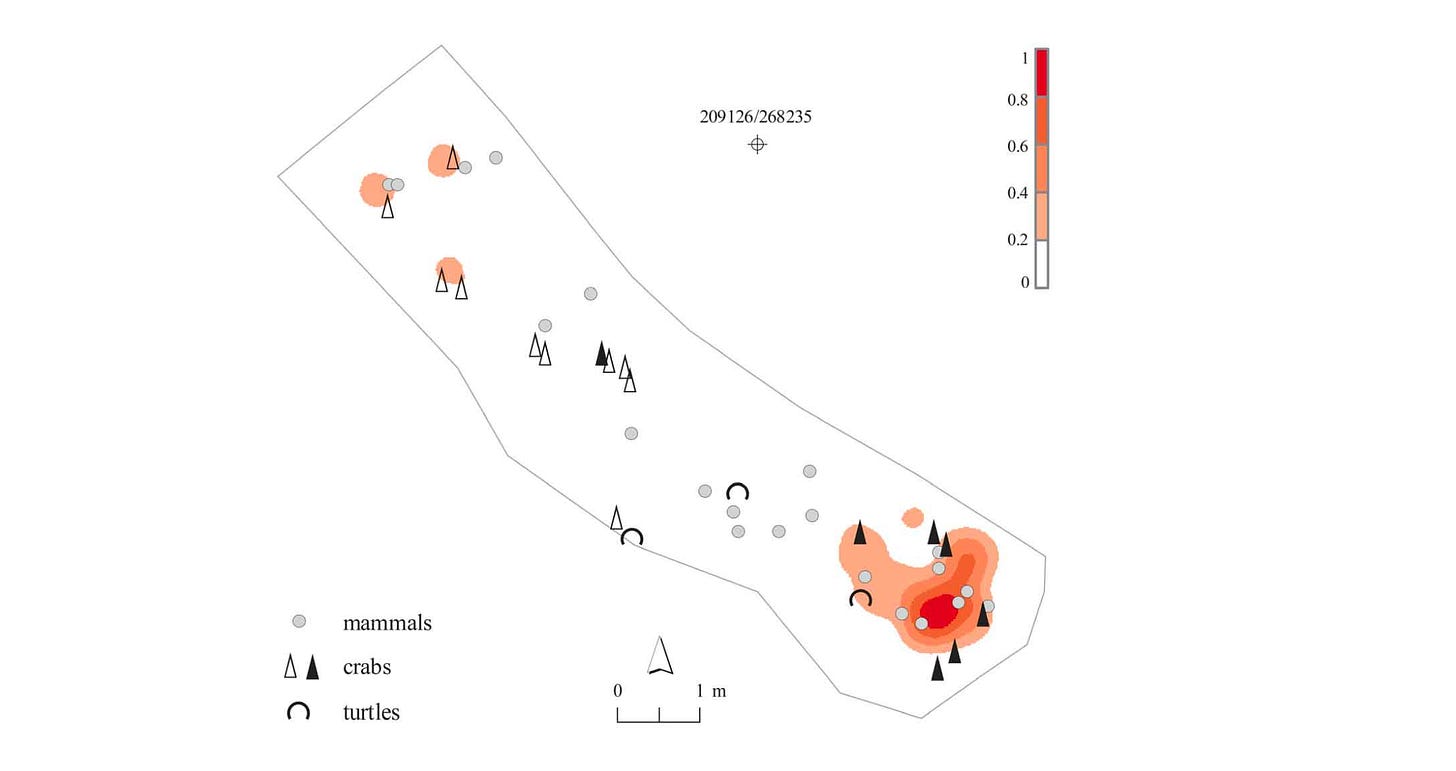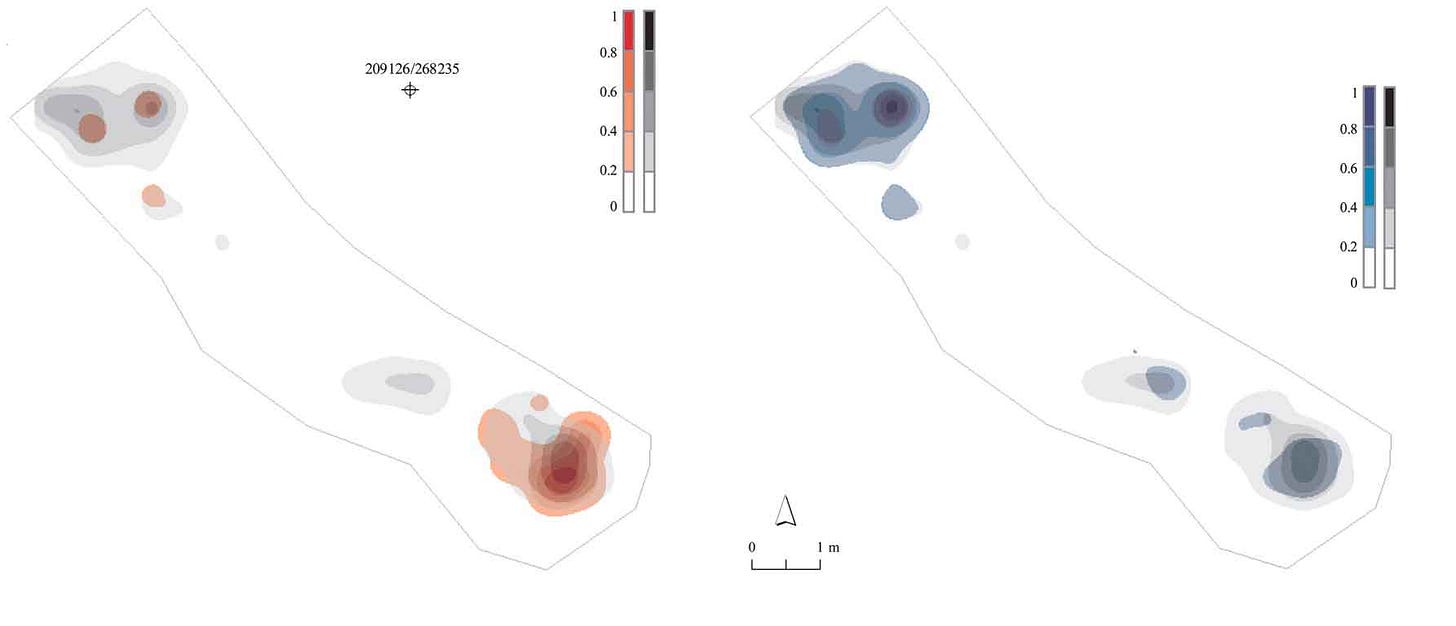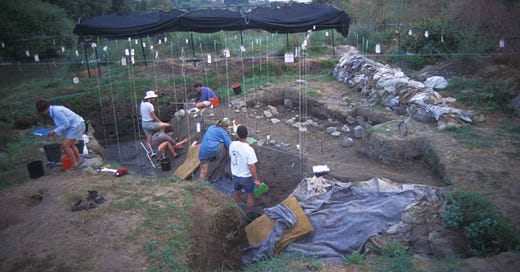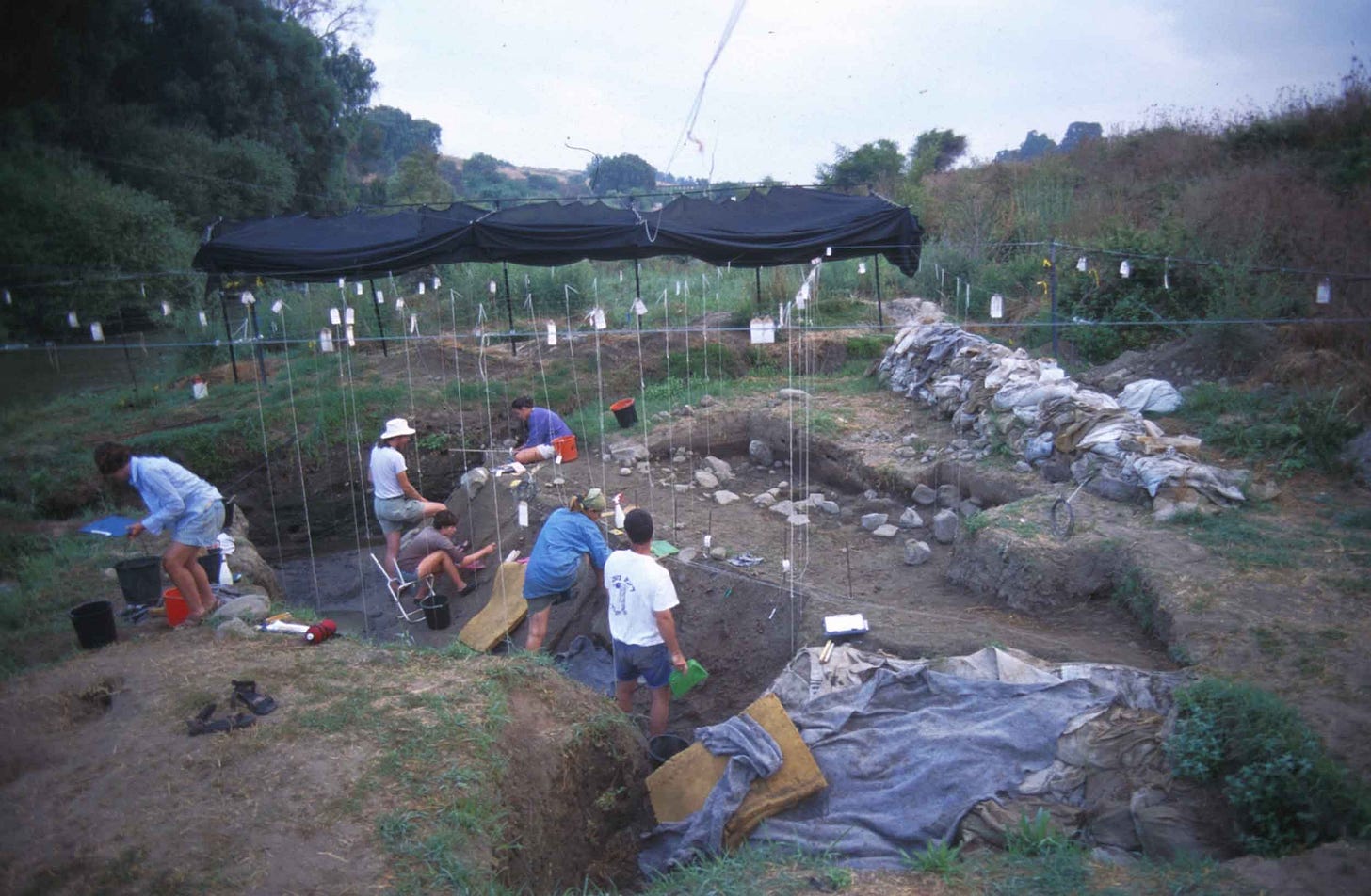Remarkable preservation of an Acheulean campsite at Gesher Benot Ya'aqov
My notes on a publication describing evidence for cooking and eating fish, crabs, and plants
Note: This post is from 2009. It accurately reports the paper discussed here and the context from the time the post was written. More recent posts discuss newer results from the Gesher Benot Ya'aqov site, as well as broader aspects of the Acheulean archaeological tradition.
In Science this week, Nira Alperson-Afil and colleagues report on recent excavations at Gesher Benot Ya’aqov, Israel. I saw some of this research presented at a conference, and I thought it was quite amazing to see the preservation of organic materials at this site. The Science paper is a good summary of the high points, presented in a very readable way.
About the site:
Gesher Benot Ya'aqov is located on the shores of the paleoLake Hula in the northern Jordan Valley in the Dead Sea Rift (7). The Early to Middle Pleistocene sediments document an oscillating freshwater lake and represent some 100,000 years of hominin occupation (Oxygen Isotope Stages 1820) dating to 790,000 years ago (8, 9). Fourteen archaeological horizons indicate that Acheulian hominins repeatedly occupied the lake margins, where they skillfully produced stone tools, systematically butchered and exploited animals, gathered plant food, and controlled fire (7, 1015).
The current paper reports on a single occupation level, characterized by a hearth feature and associated plant, animal, and artifactual remains. Some interesting things:
1. The plant remains:
Although most taxa indicate wet habitats (e.g., lakes, lake margins, swamps, and near streams), the abundant fruit remains of woodland species such as olive, oak, and officinal storax (Styrax officinalis) imply human involvement, as their habitat was likely located some distance from the lake shore. Edible plants include oak acorns, prickly water lily (Euryale ferox) seeds, and water chestnut (Trapa natans) fruits; these were probably staple foods because of the nutritive value of their starchy nuts. Through roasting, the inedible shell of the nuts can easily be peeled and the tannin content of the acorns reduced. The fruits of the wild grapevine (Vitis sylvestris) and olive, and the leaves of the white beet (Beta vulgaris) and holy thistle (Silybum marianum), may also have been consumed.
2. Crabs:
The 17 crab specimens [minimum number of individuals (MNI) = 4 (22)], identified as the extant Potamon potamios, include pieces of the two asymmetric chelipeds, each with a distinctive form of the movable (upper) and fixed (lower) pincer....Of the seven pincers of the large cheliped present in Level 2, six occur around the hearth. These are the only crab remains in this area (fig. S4) (23).
What’s not to like about people eating crabs?

3. Spatial patterning. There are two distinct areas of the horizon with anthropogenic activities—the hearth and a second cluster of tools and stone waste flakes, I’m not very excited about the spatial distribution of activities. The story in the news is about how ancient humans knew how to “keep house”. They’re selling it as a major breakthrough in cognitive evolution.
But the reason why we rarely have archaeological evidence about spatial patterning is that most archaeological horizons include events that happened over a very long time, and different groups of people may have entered and used the same space in different ways. Here’s an alternative scenario to account for the spatial pattern of remains in this horizon: One day, some people came, made tools and ate some fish. Three weeks later, some other people were in the same area, and they stayed for a few days, made a fire, did a bunch of other stuff.
That’s pretty much the spatial pattern that I would find if I went back home to Kansas and checked out campsites around the shore of the local reservoir. Few campsites are occupied for very long, and different people use them over time, sometimes with a fire, often not. Sure, we’re cognitively advanced. I’m just not convinced that the spatial distribution of our campsite trash is very good evidence about it.
Here’s what the paper includes about the spatial patterning:
The evidence from Gesher Benot Yaaqov suggests that early Middle Pleistocene hominins carried out different activities at discrete locations. The designation of different areas for different activities indicates a formalized conceptualization of living space, often considered to reflect sophisticated cognition and thought to be unique to Homo sapiens (3). Modern use of space requires social organization and communication between group members, and is thought to involve kinship, gender, age, status, and skill (2).
I think this is weak on two grounds—first because the archaeology is poor evidence about the formal conception of living space, and second because it’s not obvious that there’s anything very unique about it.
Why not unique? Any animal that can make a structure must have some capacity to pattern spatial activities – if they don’t, there’s going to be poop everywhere. Conditioned on the fact that a human social group is sharing a single space, and group members are doing more than one activity, I don’t see how you would ever expect to find a uniform scatter of evidence of these activities. There will always be some kind of spatial pattern, from the mere fact that two people can’t occupy the same space at the same time.
Remember that Gesher Benot Ya’aqov provides the earliest good evidence of human-controlled fire. It’s no coincidence that “spatial patterning” should be found with a fire – anything that people did anywhere other than by the fire is automatically evidence of a pattern.
4. Fish. Now if there is one big reason why the spatial patterning is useful, it’s the interpretation of the fish remains. It’s not in the least bit surprising that there would be a lot of fish remains on an ancient lakeshore. But the remains are clustered into two distinct parts of the site, which happen to be the very two locations that humans were clearly using.

In other words, once you accept that the archaeology gives you some evidence of where the people were within the site, you can test for association of the fauna and plant remains with the people. The crabs aren’t all around the fire because of a failed attempt to stay warm at night; the people brought them there and ate them. The fish remains are clustered around the fire and flintknapping areas because people were eating them.
Here’s a good moral of the Gesher Benot Ya’aqov story: It’s now past time to stop talking about whether “pre-modern” humans used aquatic resources. They did, sometimes intensively. I never understood why this argument about seafood and modern humans ever got any traction. We’ve known for twenty years that coastal Neandertals ate shellfish. We also have known from the numbers in caves near the coast that people never seem to have transported them very far inland. So there was a good reason why you didn’t see more evidence of seafood; there just weren’t that many sites very near the coast.
So why was it news when a bunch of coastal African sites started producing evidence of shellfish consumption? Evidence that we already had for coastal Neandertals? I don’t understand. Well, here we have people eating crabs and lots and lots of fish, 800,000 years ago. We can add the paper by Jose Joordens and colleagues earlier this year about Trinil (I reviewed it in “The shells of Trinil”), a million years ago or more.
Another reason why Gesher Benot Ya’aqov is interesting: outside Africa, Middle Pleistocene sites (and Late Pleistocene sites, for that matter) have a fairly extreme bias toward caves and rock shelters. Caves can preserve evidence of within-site spatial patterns, and certainly offer some exceptional opportunities to track human activity over long periods of time. However, humans aren’t very likely to have schlepped hundreds of fish from a lakeshore into some remote cave.
References:
Alperson-Afil N, Sharon G, Kislev M, Melamed Y, Zohar I, Ashkenazi S, Rabinovich R, Biton R, Werker E, Hartman G, Feibel C, Goren-Inbar N. 2009. Spatial Organization of Hominin Activities at Gesher Benot Yaaqov, Israel. Science 326:1677-1680. doi:10.1126/science.1180695




